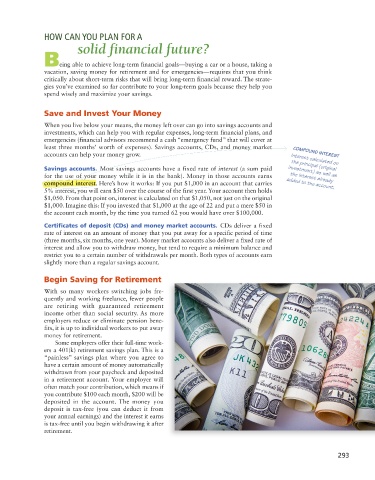Page 331 - Keys To Community College Success
P. 331
HOW CAN YOU PLAN FOR A
solid financial future?
Being able to achieve long-term financial goals—buying a car or a house, taking a
vacation, saving money for retirement and for emergencies—requires that you think
critically about short-term risks that will bring long-term financial reward. The strate-
gies you’ve examined so far contribute to your long-term goals because they help you
spend wisely and maximize your savings.
Save and Invest Your Money
When you live below your means, the money left over can go into savings accounts and
investments, which can help you with regular expenses, long-term financial plans, and
emergencies (financial advisors recommend a cash “emergency fund” that will cover at
least three months’ worth of expenses). Savings accounts, CDs, and money market
accounts can help your money grow. Interest calculated on
COMPOUND INTEREST
Savings accounts. Most savings accounts have a fixed rate of interest (a sum paid investment) as well as
the principal (original
for the use of your money while it is in the bank). Money in those accounts earns the interest already
compound interest. Here’s how it works: If you put $1,000 in an account that carries added to the account.
5% interest, you will earn $50 over the course of the first year. Your account then holds
$1,050. From that point on, interest is calculated on that $1,050, not just on the original
$1,000. Imagine this: If you invested that $1,000 at the age of 22 and put a mere $50 in
the account each month, by the time you turned 62 you would have over $100,000.
Certificates of deposit (CDs) and money market accounts. CDs deliver a fixed
rate of interest on an amount of money that you put away for a specific period of time
(three months, six months, one year). Money market accounts also deliver a fixed rate of
interest and allow you to withdraw money, but tend to require a minimum balance and
restrict you to a certain number of withdrawals per month. Both types of accounts earn
slightly more than a regular savings account.
Begin Saving for Retirement
With so many workers switching jobs fre-
quently and working freelance, fewer people
are retiring with guaranteed retirement
income other than social security. As more
employers reduce or eliminate pension bene-
fits, it is up to individual workers to put away
money for retirement.
Some employers offer their full-time work-
ers a 401(k) retirement savings plan. This is a
“painless” savings plan where you agree to
have a certain amount of money automatically
withdrawn from your paycheck and deposited
in a retirement account. Your employer will
often match your contribution, which means if
you contribute $100 each month, $200 will be
deposited in the account. The money you
deposit is tax-free (you can deduct it from
your annual earnings) and the interest it earns
is tax-free until you begin withdrawing it after
retirement.
293

